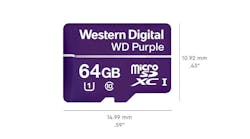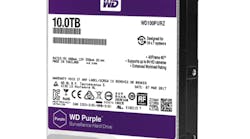The traditional methods that most enterprise-type organizations have managed their video surveillance systems no longer measure up to the pace of digitalization and the data tsunami most CSOs face on an almost minute-to-minute basis. The strain of moving from analog CCTV systems to network-centric video has essentially made closed video systems and appliances obsolete. The escalating need for speed, expanded processing power and enhanced storage capabilities dictate where an organization’s video system’s roadmap must travel.
Security Technology Executive (STE) recently sat down with both Red Hawk Fire & Security and Western Digital to get a perspective on what’s trending and what challenges are posed for enterprise-level end users who are planning to expand or update their video solutions. This exclusive Sponsored Solutions Provider Roundtable-in-Print draws some interesting perspectives from one of the country’s top systems integrators and a leading video surveillance data and storage vendor. Joining STE are Darrin Bulk, Director of Product Marketing and Client Devices at Western Digital along with Rick Tampier, a Senior Dir. Sales & Product Strategy at Red Hawk Fire & Security and Brandon Cobb, who is a Senior National Technical Project Manager with Red Hawk.
STE: The number of cameras and sophistication of new security video systems continues to grow. How can a security system integrator help you determine the best video surveillance/analytics system for your business?
Rick Tampier: You used to have only a few choices when it came to cameras and software, now the selection can be daunting. By taking an unbiased, consultative approach, the ideal systems integrator can help you sort through the array of new technology choices available and integrate solutions that both fit your needs and are within your budget. It’s important for your integrator to have a clear understanding of your goals or the main issues you need to address by using video and analytics. Are your cameras to be used for general surveillance, “situational awareness” or for a specific purpose such as document identification, facial recognition or license plate recognition (LPR)?
If you know for example, that your camera system needs to be able to identify a specific individual who shows up at your casino, spot the license plate of a prohibited vehicle, or if you need cameras that work in changing lighting conditions, it’s all vital information to communicate with an integrator that knows the best product for each individual application.
STE: What are the biggest technology trends that are shaking up (or will shake up) your markets and how are analytics and Artificial Intelligence (AI) solving real-world problems?
Darrin Bulik: There have been so many advancements over the past few years, from higher video camera resolution to the networking of camera systems to adding in deep learning capabilities, not to mention the increasing adoption of video surveillance cameras. Nowadays, it’s not that unusual to see drones flying in the field for industries like agriculture, or oil and gas, along with the more traditional video surveillance in retail stores and businesses, traffic lights, and large stadiums for example. And a lot of that expansion is to be expected. What’s really changed is how the data is being captured can be used to drive more actionable insights. Three key trends that are currently unfolding in the video surveillance space are AI-enabled systems, deep learning, and a cloud-to-edge perspective on surveillance.
AI and machine learning are key to supporting real-time responsiveness for video surveillance systems. Through machine learning, for instance, systems can be trained and adapted to identify nuances and differences in patterns, shapes, colors, sounds, vibrations and temperature, for example, which are all important and at times critical to help identify and detect issues in real time through applications like facial recognition that may be deployed for advanced identification, verification, search, prevention, response and rescue.
Deep learning takes AI capabilities even further, analyzing video data to extract valuable insights. This is an intense process as you can imagine: Effective deep learning involves higher computing power and can require thousands of hours of “training” with actual video footage to discern one human behavioral pattern. And this deep learning is taking place all along the data path, from data in the surveillance video servers at the “edge” to server-based AI-enabled NVRs, to the cloud through Video Surveillance as a Service.
The location of your data is also key, and the use cases will define this storage strategy. “Big data” is aggregated in the cloud to collect large volumes of data and analyze it over time, and can also be the data captured on NVRs in between the edge and the cloud. This is where deep learning functions operate, for example. On the other end of the spectrum, “fast data” happens at the edge on cameras and other connected devices in the field that needs quicker, even real-time, analysis for emergency situations. Take, for instance, a stadium hosting a large sporting or concert event: If surveillance detects fast movements (such as a car or motorcycle) approaching the venue in an unexpected and atypical manner, fast data allows the system to analyze the footage without any human interaction to flag urgent insights.
Tampier: It used to be that recorded video was used primarily for forensics for law enforcement or prosecution. What we’re seeing today is that with innovations in the technology there are tools that can help us take action in real time to emergencies or other situations.
One example is a large, multi-location company Red Hawk works with that recently began having parts stolen from the vehicles parked at their facilities. Digital cameras with analytics built-in can be used to identify someone crossing the perimeter of the facility combined with the ability to send an audio warning to ‘talk-down’ potentially averting a theft. If the situation escalates authorities can be automatically notified quickly.
Many of our customers are interested in video analytics and remote video because these sophisticated cameras can serve multiple purposes, not just capturing clear images of the property, but being the eyes and ears at ATM locations or documenting regulated employee practices like hand washing in healthcare facilities. There can be real value to improve business operations in addition to detecting, deterring and documenting security risks.
STE: As more video surveillance systems come online, joining the IoT, what are the biggest challenges the industry is currently facing in terms of implementation and deployment?
Bulik: With more surveillance systems becoming IP based, you’re seeing IT departments and video surveillance security departments merging, which can be a significant and challenging task. When building or upgrading video surveillance systems, this collaboration is essential for a successful deployment and one that teams need to address. For context, as you know, for a long time, the areas of IT and video surveillance deployment and management have been two separate teams, with separate skillsets, and separate approaches. As new video surveillance technologies and business needs emerge, like surveillance data streaming in from multiple points in the field through connected cameras and other video devices and video analytics, it is increasingly important for the deployment and management teams to work together and understand the additional burden these technologies place on surveillance systems. This enables them to strategize, set up, and roll out their systems effectively.
STE: What about an enterprise that has multiple locations? How best to address and implement video analytic needs when facilities are different or when circumstances vary by location?
Brandon Cobb: With the right security systems integrator, you can expect them to have the ability to deliver systems that are both standard and interoperable enterprise-wide as well as specifically geared and staged for each individual location. Red Hawk has developed its National Accounts Center of Excellence (COE) in New Orleans for this very reason.
Because innovations are being introduced so quickly, it’s proven worthwhile to bench test new technologies to determine the best uses and applications for real-world customer installations. Much of the troubleshooting and configurations are done before the product ever goes to a customer location because for some applications, setting up analytics can be a complicated and time-consuming process.
To achieve maximum efficiency and consistency for large-scale, national projects, we often pre-build or stage equipment and program security systems before they go out. Then, the team at the COE serves as a central resource for field technicians at installation time. Due to their up to the minute training and product knowledge, the team here is able to identify common problems quickly and promptly resolve any issues that crop up. For more complex matters, the team here can also remote into systems when needed.
STE: Is it always necessary to start from scratch to implement a video surveillance/analytic system or can you utilize existing equipment and upgrade the system in stages?
Tampier: One of the largest casinos in North American faced this very dilemma as it grew and expanded. Red Hawk was able to complete a multi-phased project to update the resort’s analog video system to full color, IP cameras and a networked video management system. The upgrade required that the new cameras and existing analog products work together for a seamless integration which can be adapted as the casino continues to expand in the future.
When it comes to security technologies, it’s not a “one and done” approach because not only is the technology changing, but the threats are evolving as well. That’s why it’s so crucial to have a trusted, long-term relationship with your integrator who knows your business needs as well as your security risks.
STE: Darrin, you mentioned some of the enterprise-level environments, like stadiums. Where do you see technology advancements impacting these areas?
Bulik: Overall, across industries, the amount of data generated by surveillance solutions is on the rise. IDC anticipates this data increase to grow by 25 percent per year through 2021[i], driven by several factors including an increasing adoption of video – and networked – video camera, higher video camera resolutions and significant improvements in camera technologies.
With enterprise-level environments, AI-based applications like facial recognition offer tremendous value in maintaining a safe environment. For instance, leveraging facial recognition applications to conduct advanced identification, verification, search, prevention, response and rescue are options. AI surveillance cameras could soon identify faces in a crowd with up to 99 percent accuracy. Facial recognition applications can identify behavioral patterns that can be used to develop new insights, for instance offering retail businesses new insights on shoplifter recidivism.
Wearable surveillance is also an exciting area for enterprise-level video surveillance systems who are looking for diverse but reliable solutions for police and security guards to protect public spaces including parks, stadiums, government offices, airports and transit stations, and public areas where people congregate such as churches and malls. Body cams are worn in different places such as on caps, over one’s ear, or across the chest with an audio headset attached for real-time communication. Body cams are typically set to record live data at all times.
STE: How can we integrate our video system with other security products?
Tampier: By integrating all security systems, including video surveillance, access control, and intrusion systems, you can greatly increase the effectiveness of your equipment and improve the layers of safety at a property. Connecting all these systems such as fire alarm, nurse-call, mass notification as well as IoT devices greatly enhances how a business can react to a situation. The best systems utilize analytics and AI to manage and react to a large amount of data available.
These systems are able to pay for themselves in terms of improved business operations, critical condition monitoring and life safety.
STE: Where do data and data storage fit into the video surveillance system puzzle?
Bulik: In this age of digital transformation, the surveillance industry is undergoing its own evolution, leveraging the new capabilities provided by the IoT and Big Data to evolve beyond traditional capture-and-reference use cases. From input captured by video cameras and other “things” in the Internet of Things in the field – on systems that are operating 24/7 – to analysis and storage of that data, storage for the surveillance industry is expanding to support business needs from the edge to the core.
As an example, network video recording system, NVRs, are getting smarter, and with new capabilities like AI providing object and facial recognition, video surveillance systems can offer greater insights that feed directly back into organizations’ operations and security capabilities. With these emerging capabilities comes the need for advancements on the technology side. For instance, when you look at individual traditional cameras and AI-enabled NVRs, the NVRs will require both more storage capacity and more sophisticated processing in order to perform advanced analytics like the location of an individual face image from weeks or months of stored video, or the creation of traffic heat maps from hours of retail surveillance video to provide insights on behavior prediction.
“Training” for deep learning applications requires thousands of hours diving into real video footage, which requires users to hold onto more footage and for longer amounts of time, driving the need for greater storage for real-time, short-term and long-term options.





